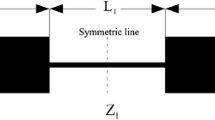Abstract
In this paper, a new high-temperature superconducting (HTS)-based microwave radiometer with an improved sensitivity is presented. The cryogenic receiver front end consists of an HTS filter and a cryogenic low noise amplifier (LNA). The cryogenic receiver front end shows an ultra-low noise figure and can suppress radio frequency interference (RFI) effectively. The proposed HTS filter works at a center frequency of 1.4135 GHz with a bandwidth of 25 MHz. The measured mid-band insertion loss, side band steepness, and out-of-band attenuation of the HTS filter are 0.14 dB, 35 dB/MHz, and 80 dB, respectively. The noise figure of the cryogenic LNA is about 0.27 dB at a temperature of 77 K. Compared with other total power radiometers, the proposed radiometer has a lower receiver noise temperature, which can improve the sensitivity with a short integration time of the satellite-based salinity meter. In addition, since the bandwidth of the salinity meter is fixed and the integration time of satellite-based equipment is limited, such a low receiver noise temperature can increase the flexibility of future satellite payload configuration program.




Similar content being viewed by others
References
Font, J., Lagerloef, G.S.E., Levine, D.M.: The determination of surface salinity with the European SMOS space mission. IEEE Trans Geosci Remote Sens. 42, 2196–2205 (2004)
Levine, D.M., Lagerloef, G.S.E., Yueh, S.H.: Aquarius: an instrument to monitor sea surface salinity from space. IEEE Trans Geosci Remote Sens. 45, 2040–2050 (2007)
Yueh, S.H., Chaubell, J.: Sea surface salinity and wind retrieval using combined passive and active L-band microwave observations. IEEE Trans Geosci Remote Sens. 50, 1022–1032 (2012)
Crosson, W.L., Limaye, A.S., Laymon, C.A.: Parameter sensitivity of soil moisture retrievals from airborne L-band radiometer measurements in SMEX02. IEEE Trans Geosci Remote Sens. 43, 1517–1528 (2005)
Dong, J., Li, Q., Shi, R., Gui, L.: The placement of antenna elements in aperture synthesis microwave radiometers for optimum radiometric sensitivity. IEEE Trans Antennas Propag. 59, 4103–4114 (2011)
Eskandari, S., Hamedani, F.T.: Progress of millimeter wave radiometers sensitivity, designing a wideband low noise amplifier. Antenna Technology and Applied Electromagnetics, France, Toulousem. pp. 1–5 (2012)
Zhu, L., Liu, Y.Y., Huang, D.C.: The sensitivity improvement method of direct sampling microwave radiometer, pp. 1168–1171. Antennas Propagation and EM Theory, China, Guangzhou (2010)
Hersman, M.S., Poe, G.A.: Sensitivity of the total power radiometer with periodic absolute calibration. IEEE Trans Microwave Theory Tech. 29, 32–40 (1981)
Pal, S., Stevens, C.J., Edwards, D.J.: Compact parallel coupled HTS micro-strip bandpass filters for wireless communications. IEEE Trans Microwave Theory Tech. 54, 768–775 (2006)
Niu, D.C., Huang, T., Lee, H.J., Chang, C.Y.: An X-band front-end module using HTS technique for a commercial dual mode radar. IEEE Trans. Appl. Supercond. 15, 1008–1011 (2005)
Kawaguchi, T., Shiokawa, N., Nakayama, K., Yamazaki, K.: High-sensitivity HTS receiver module with hermetic thermal insulation waveguides. Microwave Conference. pp. 955–958 (2003)
Sun, L., He, Y.: Research progress of high temperature superconducting filters in China. Trans Appl Superconductivity. 24, 1–8 (2014)
Wu, Y., Sun, L., Li, C., et al.: Developments of microwave HTS-based devices and subsystems for applications in civilian satellites. IEEE, International Kharkov Symposium on Physics and Engineering of Microwaves, Millimeter and Submillimeter Waves. pp. 46–51 (2013)
Stephen, J.S., Graeme, L.J.: Wide-band orthomode transducers. IEEE Trans Microwave Theory Tech. 39, 294–300 (1991)
Chung, Y. S., Dunning, A., Bowen, M.A.: Ultra sharp roll-off bandpass filter design for near pass-band RFI mitigation. Asia Pacific Microwave Conference. pp. 491–493 (2013)
Chen, Y., Li, Z.K., Wu, K.L., et al.: Microwave and millimeter-wave cryogenic wideband LNA design and characterization. Asia-Pacific Microwave Conference. 2 (2016)
Mcculloch, M.A., Grahn J., Melhuish S.J., et al..: Dependence of noise temperature on physical temperature for cryogenic low-noise amplifiers. J. Astron. Telesc. Instrum. Syst. 3(1) (2017). https://doi.org/10.1117/1.JATIS.3.1.014003.
Liu, H.F., Jin, C.J., Cao, Y., et al.: High linearity, low noise, L-band cryogenic amplifier for radio astronomical receivers. Microw. Opt. Technol. Lett. 59, 500–505 (2017)
Pozar, D.M.: Microwave Engineering, 4th ed. Publishing House of Wiley, Hoboken (2005)
He, Y.S., Li, C.G.: Superconducting receiver front-end and its application in meteorological radar. In: Kouemou, G. (ed.) Radar Technology. In Tech, Vukovar (2010)
Satoh, K., Narahashi, S., Nojima, T., et al.: The 2 GHz high temperature superconducting receiver equipment for mobile communications. Physica C: Superconductivity and its Applications. 357, 1495–1502 (2001)
Wang, Z., Xie, Y., Lu, H., et al.: Calibration and impact analysis of 23.8 GHz digital-correlation full-polarimetric microwave radiometer. Remote Sensing Technology and Application. 30, 744–756 (2015)
Xie, W., Wang, P., He, M., et al.: Double-sided Tl2Ba2Ca2Cu3O10 thin films based high temperature superconducting filter operating above 100 K. Appl. Phys. Lett. 105, 1–3 (2014)
Skou, N., Vine, D.L.: Microwave Radiometer Systems, 2nd edn. Artech House Remote Sensing Library, Boston (2006)
Wei, E.B., Liu, S.B., Wang, Z.Z., Tong, X.L., et al.: Emissivity measurements of foam-covered water surface at L-band for low water temperatures. Remote Sens. 6, 10913–10930 (2011)
Zribi, M., Parde, M., Boutin, J.: AROLS: a new airborne L-band radiometer for ocean surface and land observations. Sensors. 11, 719–742 (2011)
Wang, Y., Heron, M.L., Prytz, A., et al.: Evaluation of a new airborne microwave remote sensing radiometer by measuring the salinity gradients across the shelf of the Great Barrier Reef Lagoon. IEEE Trans Geosci Remote Sens. 45, 3701–3709 (2007)
Funding
This work was supported by the National Natural Science Foundation of China (Grant No. 61171028, Grant No. 61176119, Grant No. 61471208, Grant No. 61841108), the Natural Science Foundation of Tianjin (No. 15JCQNJC01300), and the Tianjin Key Laboratory of Optoelectronic Sensor and Sensing Network Technology.
Author information
Authors and Affiliations
Corresponding author
Additional information
Publisher’s note
Springer Nature remains neutral with regard to jurisdictional claims in published maps and institutional affiliations.
Rights and permissions
About this article
Cite this article
Wang, L.T., Xiong, Y., Xiao, Y.H. et al. A High-Order L-Band HTS Filter for Sensitive Detecting. J Supercond Nov Magn 32, 2849–2856 (2019). https://doi.org/10.1007/s10948-019-5070-z
Received:
Accepted:
Published:
Issue Date:
DOI: https://doi.org/10.1007/s10948-019-5070-z




